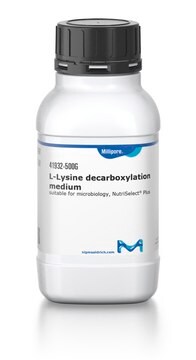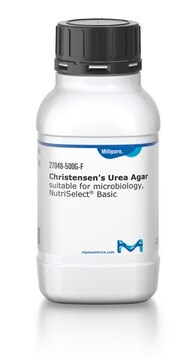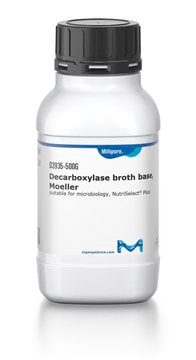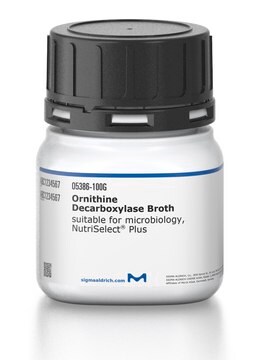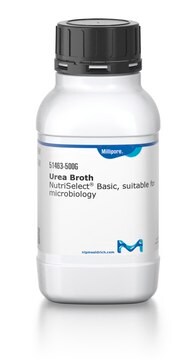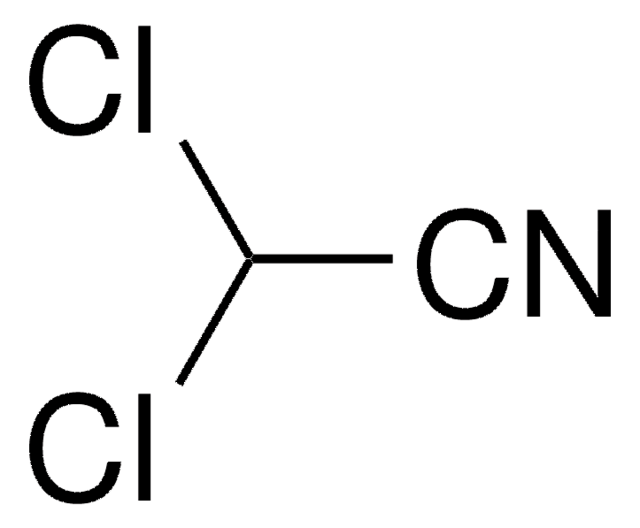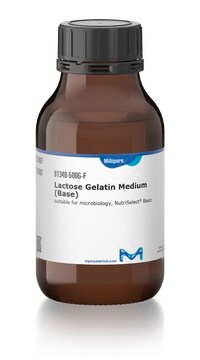Wichtige Dokumente
66304
Lysin-Decarboxylase-Bouillon
suitable for microbiology, NutriSelect® Plus
Synonym(e):
LD-Bouillon
About This Item
Empfohlene Produkte
Agentur
according to ISO 10273:2017
Qualitätsniveau
Sterilität
non-sterile
Form
powder
Haltbarkeit
limited shelf life, expiry date on the label
Zusammensetzung
bromo creol purple, 0.02 g/L
dextrose, 1 g/L
L-lysine hydrochloride, 5 g/L
peptic digest of animal tissue, 5 g/L
yeast extract, 3 g/L
Hersteller/Markenname
NutriSelect® Plus
Methode(n)
microbe id | specific enzyme detection: suitable
microbiological culture: suitable
pH-Endwert
6.8±0.2 (25 °C)
Anwendung(en)
clinical testing
environmental
food and beverages
microbiology
Eignung
Enterobacter spp.
nonselective and differential for Salmonella spp.
nonselective and differential for enterobacteriaceae
Anwendung
Angaben zur Herstellung
Fußnote
The designations basic, plus, or prime are added to indicate the quality control level, from basic quality control to standard QC plus to prime for full regulatory compliance.
Rechtliche Hinweise
Lagerklassenschlüssel
11 - Combustible Solids
WGK
WGK 1
Flammpunkt (°F)
Not applicable
Flammpunkt (°C)
Not applicable
Persönliche Schutzausrüstung
Eyeshields, Gloves, type N95 (US)
Hier finden Sie alle aktuellen Versionen:
Besitzen Sie dieses Produkt bereits?
In der Dokumentenbibliothek finden Sie die Dokumentation zu den Produkten, die Sie kürzlich erworben haben.
Kunden haben sich ebenfalls angesehen
Artikel
Sigma-Aldrich.com presents an article concerning Differentiation of Escherichia coli from coliforms.
Salmonella contamination is the second leading cause of food-borne illness worldwide. Controlling outbreaks of Salmonella is an important task for food regulators, restaurants and the food industry in general. The Salmonella family includes over 2,300 serotypes of bacteria, but two types, Salmonella enteritidis and Salmonella typhimurium, are responsible for about half of all human infections. Most outbreaks of Salmonella are traced back to dairy, poultry and meat products, but Salmonella can grow on nearly any food. Chicken, eggs and their derivative products are particularly high risk.
Unser Team von Wissenschaftlern verfügt über Erfahrung in allen Forschungsbereichen einschließlich Life Science, Materialwissenschaften, chemischer Synthese, Chromatographie, Analytik und vielen mehr..
Setzen Sie sich mit dem technischen Dienst in Verbindung.